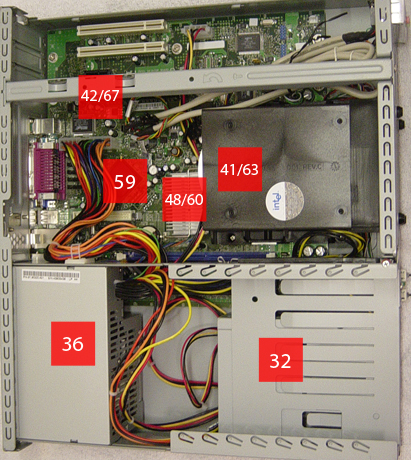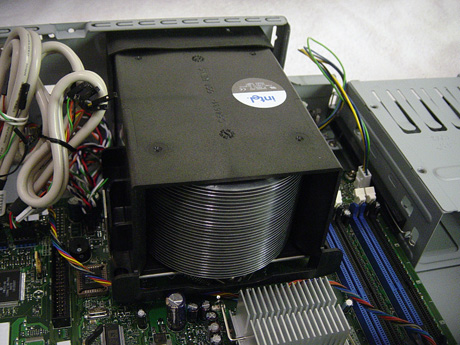Intel's Long Awaited BTX Form Factor
by Purav Sanghani on November 15, 2004 5:31 AM EST- Posted in
- Cases/Cooling/PSUs
Thermals Micro BTX (uBTX)
This is where everything we have heard about the BTX form factor is either proven right or wrong. Intel claims BTX the better design to efficiently cool more components with less equipment while using less power and space. Intel released a virtual press kit on their BTX form factor in April of this year. Unfortunately, the press kit is a little too general to really draw many conclusions, but feel free to judge for yourself.Intel's press kit reports that the BTX design cools the CPU to 2 degrees lower than the ATX form factor while only providing 40 cubic feet per minute, or 40 cfm with our Type I Thermal Module. ATX, on the other hand, requires 150 linear feet per minute, or 150 lfm.
We performed our inch by inch temperature observation with the D915GMH microBTX motherboard and the Pentium 550 CPU in the AOpen B300 which is 15" in width by 13" in depth.

Click to Enlarge
From our results above we see that the temperatures of each square inch of the case are a few degrees higher than those we found on our ATX Ahanix D.Vine 5 chassis. The warmest pocket of air hovers between the PCIe card, Southbridge, Northbridge, and CPU. This area, which averages about 35 degrees, is warmer than the ATX ambient average of about 32 degrees. Intel's whitepaper was not clear on the equipment they used to get the results in their table but from our results, the standard ATX system performs cooler than the BTX system. The microATX system, however, produced temperatures higher than those of the microBTX system.

Click to Enlarge
The results for the core temperatures of each component shown above also tell us that the microBTX equipment does not exactly perform better than the ATX hardware, but for the amount of fans in the system, microBTX is more efficient when it comes to cost of energy and space. With only the CPU's HSF and the power supply's single 80mm fan, the uBTX system performs at temperatures lower than an uATX system with three case fans and a dedicated CPU HSF.

Click to Enlarge
These temperatures are not set in stone for every processor Intel manufacturers or will release in the future. Each will require a different thermal module according to their Thermal Design Power rating. For example, The Pentium 550J will come bundled with a Type I Stacked-fin module whereas the Pentium 560J will come with the Type I Spiral-fin module. Obviously the spiral-fin module will dissipate heat better than the stacked fins.










77 Comments
View All Comments
trikster2 - Tuesday, November 16, 2004 - link
I've got to say, this review is bad, even by anandtech standards.
Comparing an mBTX destop to a mATX TOWER to a Fullsize ATX desktop, litteraly comparing apples to oranges to pears, and then coming to sweeping conclusions like "any of us were skeptical for a long time, but after seeing the numbers ... we can conclude that BTX is not hype. " is simply ludicrouse.
Shame on you anand for letting such a review fall through your QC into the hands of the general public.
I'm not sure if you guys are incompetent or payed by intel to find a combo to pimp the BTX standard. I just did a refresh 5 times, no intel adds so it must be the former.
How about spending 49.95 on a decent desktop mATX case and compare apples to apples, instead of just grabbing whatever was laying around the lab (we've seen that whacked oppus case in other reviews haven't we?)?
I have the silverstonetek equivalent of the oppus matx tower. It is the worst mATX cases I have ever worked with. Give us a break and do a valid review, mATX single fan 1/2 height desktop to mBTX single fan 1/2 height desktop.
johnsonx - Tuesday, November 16, 2004 - link
I see nothing here in the BTX standard that couldn't have been better accomplished with a backwards and forwards compatible ATX II standard.ATX II compliant motherboards would have standardized locations for the CPU socket, two standard locatations for RAM (either or both locations could be used, as needed), standard locations for the power connectors, standard locations for the most common onboard ports (IDE, SATA, front USB, audio, etc.) and standard component heights (capacitors and etc.).
ATX II compliant cases would have standardized air intake and exhaust locations, fan mounts, and ducting. ATX II cases could be built to open from the right side, with the CPU on the bottom. The ducting would be removeable for use with a legacy ATX mainboard.
ATX II compliant heatsinks would be fanless, designed to be cooled by an ATX II chassis duct, but would have a fan mounting point for use in a legacy ATX chassis. Boxed coolers that come with retail CPU's would include the fan on a standard clip with instructions to remove it when used with an ATX II compliant chassis and mainboard.
ATX II compliant power supplies would basically be the same as the latest ATX supplies are now - 24pin power, 8-pin ATX 12v power, standard 4-pin drive power plugs, SATA power plugs, PCI-E graphics power plug. 24 to 20 pin converters and 8-pin to 4-pin converters would be standard with retail power supplies.
Any mix of ATX and ATX II components would work fine together, but a system built of all ATX II components would gain various cooling, noise level, assembly and operational advantages.
What does BTX offer that my hypothetical ATX II standard doesn't? Oh, yeah... ATX II couldn't give you a face of hot air...
xsilver - Monday, November 15, 2004 - link
To the guy b4 that was wondering where the air intakes are -- no amount of case fans are going to create a vacum inside your case, there's just not enough pressure -- unless you tape up all the gaps lol.... so the air will just "flow" in from any holes in your caseblackmetalegg - Monday, November 15, 2004 - link
Bah we're(work) using this motherboard in an application that shall remain anonymous(NOT oridinary PC) and the damn design make wiring a bitch to deal with. And the motherboard isn't all that stable, considering it's from Intel...justly - Monday, November 15, 2004 - link
BTW that 20.666715 "cfm" is assuming all of the area taken by the 2 fans has air flow, but we should all knoe that the motor and frame ocupy some of that space so the actual "cfm" would be lower.justly - Monday, November 15, 2004 - link
Why was "lfm" not converted to "cfm" for a direct comparison on page 11?If I am reading this correctly the BTX provides 40 "cfm" while the ATX requires 150 "lfm". This sounds like BTX is an overwhelming success, untill you do the conversion that is. So what exactly does this 150 "lfm mean in comparison, well if the ATX uses 2-80mm fans that would be 80mm x 80mm = 6400 square mm per fan, 6400 x 2 = 12800 square mm for both fans, convert that to square ft and you get 0.1377781 square ft, take that and multiply by the 150 "lfm" and we get (drum roll) 20.666715 "cfm". Thats right about half what the BTX has.
I don't know if this was intentional or not, but I will give the author the benifit of the doubt and assume it was not.
If I have overlooked something please explain my mistake, if not then I feel some injustice has been done to the readers that did not ask this question.
ShadowVlican - Monday, November 15, 2004 - link
like someone else said... the BTX form wasn't made for enthusiasts, since we already know how to cool our rigs properly..BTX is for the average consumer who doesn't know jack about computers, so BTX will help those people have quieter/cooler computers without them reading forums/articles
i'm just wondering how well the transition from ATX machines into BTX will go...
ZobarStyl - Monday, November 15, 2004 - link
Yes Five40, you can't directly upgrade from 754 to 939, but you can take your case and PSU with you...I'm using the same case I used in my AXP system now for an A64 with watercooling, but if Intel has their way, my next rig won't be able to use the same rig and I'll just have to spend more cash. Hence, we are rightfully pissed because the real question is "Why?" and when something lacks benefits but costs you mad cash: a whole new case and good PSU will set me back 120 bucks, for what? Nothing worth my time.MAValpha - Monday, November 15, 2004 - link
Anyone know how pBTX stacks up against FlexATX?five40 - Monday, November 15, 2004 - link
#50....umm I can't do a A64 to A64 upgrade so what's your point? 754 to 939 does me no good. I just see this as another socket update. A64 might not need it right now, but if all things where just made for what we need right now, we'll move forward at a very slow pace.